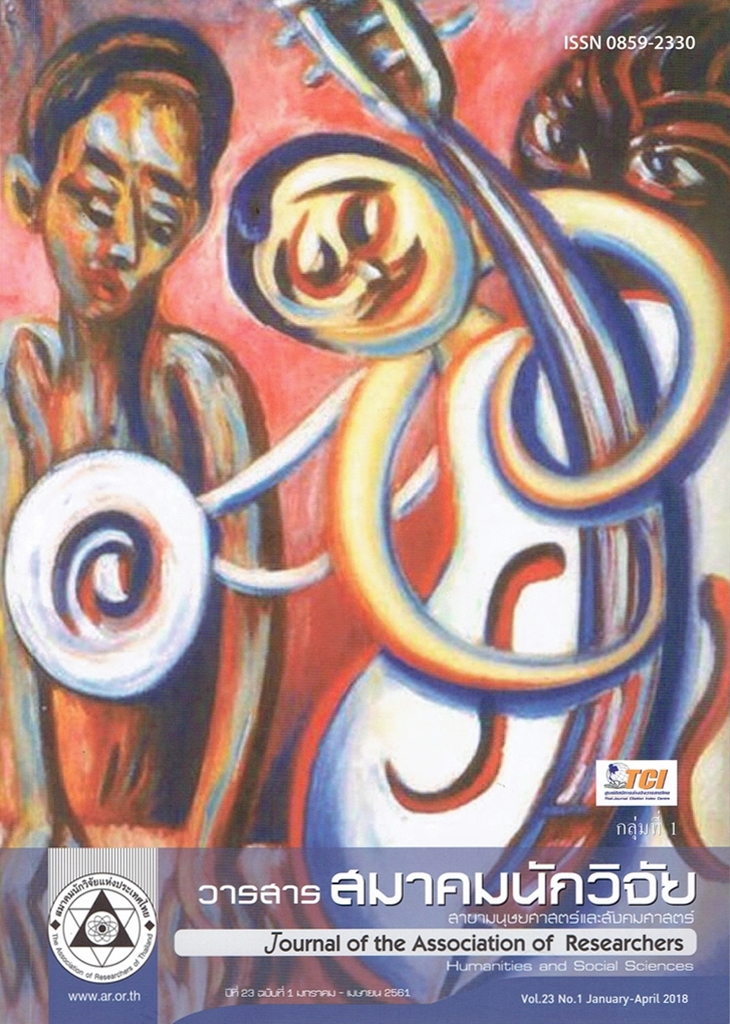Influences of Socially Responsible Leadership and Stakeholders’ Perception of Corporate Social Responsibility on Association Image of the Gymnastics Association of Thailand
Main Article Content
Abstract
The objectives of this research were 1) to study influences of the socially responsible leadership that it could explain and predict both side of association image of the Gymnastics Association of Thailand and Stakeholders’ Perception of social responsible recognition of organization. And 2) to study the influence of the socially responsible leadership on association image of the Gymnastics Association of Thailand both direct and indirect via Stakeholders’ Perception of social responsible recognition of organization. Samples were athletes, gymnasts and related persons. Judgmental sampling was randomly, and completely sample size was 400. The results found that correlation coefficient among observable variables were 0.570 - 0.765; and every variables had a significant level. From structural equation modeling, it found that socially responsible leadership had influence on Stakeholders’ Perception of social responsible recognition of organization with significantly and the variance predicted by servant leadership with 78.00 percent. Moreover, socially responsible leadership had direct effect to association image with significantly and had indirect effect via Stakeholders’ Perception of social responsible recognition of organization with significantly and variance predicted by servant leadership with 79.90 percent. Finally, Stakeholders’ Perception of corporate’s social responsibility had direct effect to association image of the Gymnastics Association of Thailand with significantly. Fit indices of the model were χ2 / df = 1.543, CFI = 1.00, NNFI = 1.00, RMSEA = 0.037 and 90% CI for RMSEA = 0.0 ; 0.061
Article Details
บทความที่ปรากฏในวารสารนี้ เป็นความรับผิดชอบของผู้เขียน ซึ่งสมาคมนักวิจัยไม่จำเป็นต้องเห็นด้วยเสมอไป การนำเสนอผลงานวิจัยและบทความในวารสารนี้ไปเผยแพร่สามารถกระทำได้ โดยระบุแหล่งอ้างอิงจาก "วารสารสมาคมนักวิจัย"
References
จินตวีร์ เกษมศุข. (2551). ประสิทธิผลของการใช้สื่อบุคคลในการประชาสัมพันธ์เพื่อสร้างภาพลักษณ์ของสถาบันอุดมศึกษา เอกชน. กรุงเทพฯ: มหาวิทยาลัยศรีปทุม.
พิพัฒน์ นนทนาธรณ์. (2558). ปัจจัยเชิงสาเหตุของภาวะผู้นำที่รับผิดชอบต่อสังคมที่มีอิทธิพลต่อภาพลักษณ์องค์การของ ท่าอากาศยานสุวรรณภูมิ. วารสารสมาคมนักวิจัย. 20(2), 48-58.
___________(2559ก). อิทธิพลของภาวะผู้นำที่รับผิดชอบต่อสังคม การรับรู้ของผู้มีส่วนได้ส่วนเสียด้านความรับผิดชอบ ต่อสังคมขององค์การที่ส่งผลต่อภาพลักษณ์องค์การของท่าอากาศยานเชียงใหม่. วารสารสมาคมนักวิจัย. 21(2), 202-214.
___________(2559ข). การจดัการความรบัผดิชอบตอ่สงัคมและองคก์าร: การสรา้งขอ้ไดเ้ปรยีบในการแขง่ขนั อยา่งยงั่ยนื. พิมพ์ครั้งที่ 2. กรุงเทพฯ : ศูนย์ผู้นำธุรกิจเพื่อสังคมแห่งมหาวิทยาลัยเกษตรศาสตร์.
รำไพ ศูนย์จันทร์ สาลี่ สุภาภรณ์ และอุษากร พันธ์วานิช. (2558). การบริหารจัดการเพื่อพัฒนายิมนาสติกศิลป์สู่ความเป็น เลิศตามการรับรู้ของผู้ที่มีส่วนเกี่ยวข้อง. มหาวิทยาลัยศรีนครินทรวิโรฒ: สถาบันพละศึกษา วิทยาเขตชัยภูมิ.
สมยศ แสงสุวรรณ. (2546). “ภาพลักษณ์นั้นสำคัญยิ่ง.” วารสารการอ่าน 15(1): 57-59.
References
Carroll, Archie B. (1991). Corporate Social Responsibility: Evolution of a Definitional Constructmore. Business and Society, Vol. 38, No. 3, (September).
Chintawee, Kasemsuk. (2007). The Effectiveness of Interpersonal Channels for Creating Image of Private University. Report: Sripatum University. (in Thai).
Hooper, D., J. Coughlan and M.R. Mullen. 2008. “Structural Equation Modeling: Guidelines for Determining Model Fit”. The Electronic Journal of Business Research Methods 6(1): 53 – 60.
Jirawatsawong, Kittipong. (2010). “ISO 26000 Corporate Social Responsibility System Standard.” Industrial Technology Review (215): 122-125; (216): 106-109; (217): 119-122. (in Thai).
Leech, N.L., K.C. Barrett and G.A. Morgan. 2005. SPSS for Intermediate Statistics: Use and Interpretation. 2nd ed. Mahwah, NJ.: Lawrence Erlbaum.
Nonthanathorm, Phiphat. (2015). Causal Factors of Socially Responsible Leadership Influencing on Corporate Image of Phuket International Airport. Proceeding of International Conference on Applied Business Research, 677-685.
___________(2015). Causal Factors of Socially Responsible Leadership Influencing to Corporate Image of Suvanabhumi Airport. Journal of the Association of Researchers. 20(2), 48-45. (in Thai).
___________(2016a). Corporate Social Responsibility Management: Creating Sustainable. Bangkok: Social Enterprise Leadership Center. (in Thai).
___________(2016b). Influences of Socially Responsible Leadership and Stakeholders’ Perception of Corporate Social Responsibility on Corporate Image of Chiang Mai International Airport. Journal of the Association of Researchers. 21(2), 202-214. (in Thai).
Philip, K. (2014). Marketing Management 16th Edition. New Jersey: Prentice-Hall Inc.
Soonjan, S., P. (2015). Administration for Developing Excellent Artistic Gymnastics as Perceived by Stakeholders. Srinakharinwirot University: Institute of Physical Education Chaiyaphum. (in Thai).
Somyod Sangsuwan. (2003). The image is important. Reading journal. 15(1): 57-59. (in Thai). Waldman, David A. (2007). Best Practices in Leading at Strategic Levels: A Social Responsibility Perspective in Jay A. Conger and Ronald E. Riggio, (Eds), The Practice of Leadership, San Francisco: Jossey-Bass.


